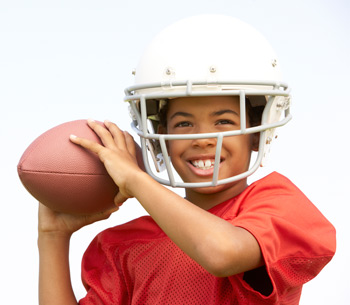 Overview
Overview
According to the National Electronic Injury Surveillance Survey (NEISS), an estimated 466,492 people were treated for football related injuries in 2012. Football is the leading cause for disastrous sports injuries among male high school and college athletes. Children as young as 5 are playing in full contact leagues and wearing pads.
Common Injuries
Overuse injuries can occur from heavy training and conditioning. However, traumatic injuries are most common in football because it is a high contact sport. High-speed hits with other players and the ground can lead to concussions, fractures, and sprained or torn ligaments.
The injuries can involve the:
Head: Concussions are very common in football. Even with a helmet, players can be injured from a direct hit to the head or from sudden jerking motions during a hit. You do not have to pass out to have a concussion. A child with a concussion may have a headache, confusion, dizziness, nausea/vomiting, or blurry vision. Any player with signs of a concussion needs to be immediately removed from play, checked by a medical professional, and cleared before return to play.
Shoulder: Shoulder dislocations and separations are common in football. A shoulder separation is actually a sprain of the joint near your collarbone, known as the AC (acromioclavicular) joint. In growing children and young teenagers, a fracture at the growth plate of the end of the clavicle is more common than an AC separation. Tears along the tissue of the shoulder socket and unstable shoulders (partial dislocation) can also happen, especially in linemen.
Knee: Especially among young children, football is a leading cause for serious knee injuries. Common knee ligament injuries include the ACL (anterior cruciate ligament) and MCL (medial collateral ligament). These injuries often happen after a tackle. Knee injuries can affect not only ligaments, but also the meniscus and cartilage in the joint. This can lead to early arthritis. The growth plate is weaker than tendons and ligaments, and younger children may get fractures around the knee instead of a ligament tear. Although many NFL football players wear custom knee braces, braces have not been shown to decrease knee injuries. Many athletes feel that they cannot perform as well in the brace.
Heat Injuries: Because football practice often starts at the end of summer, heat injuries can occur. They can range from heat exhaustion to heat stroke, which can result in death. Proper hydration is important to avoid serious injury! Players and coaches should be taught to look for signs of heat exhaustion and speak up to prevent heat injury.
Page QR Code:

Before You Play
Warm up exercises and stretching is very important to prevent injuries. Teenage athletes are growing quickly, and tight muscles can lead to muscle strains and even fractures. Careful stretching of the front of the leg and thigh (hip flexor and quadriceps) and the back of the leg (hamstrings) every day can help to prevent these types of injuries.
Equipment
Proper safety equipment is important to protect a player’s body during collision. Equipment should be in good condition and fit correctly. The list includes:
- Well-fitting helmet with facemask
- Mouth guard (with strap)
- Shoulder pads
- Hip, thigh, tail, and kneepads
- Football pants (may include pads)
- Jock cup
- Cleats(ask coach which type of cleats are allowed in your league)
Injury Prevention Tips
- Have a pre-season physical to find any conditions, injuries, or problems that could lead to in-season injuries. This is the best chance to identify any abnormalities of the heart rate, blood pressure, or heart murmurs. The stress of conditioning, practice, and game participation can lead to serious consequences if these abnormalities are not known in advance.
- If it is available, do an IMPACT test at the beginning of the season, before an injury happens. The IMPACT test is a computer test to watch concussions. This test helps decide when a player is able to return to play after a concussion. You can find a provider who does IMPACT testing in your area at: https://www.impacttest.com/find_care_provider/
- At the beginning of each season, make sure your equipment is in good condition and fits well.
- Condition in the off-season to improve strength and endurance.
- Learn and continue a good stretching program. This is very important for growing children and teenagers to prevent injury.
- Hydrate before and during games to prevent cramping. Adequate drinking water must be available to all participants.
- If muscle cramping does occur, notify coaches or trainers immediately! This may be an early sign of heat injury.
- Learn proper tackling techniques. Keep your head up- never lead a tackle with your helmet.
- Make sure that coaches are encouraging safe play.
More Information

 POSNA.org
POSNA.org
 Overview
Overview